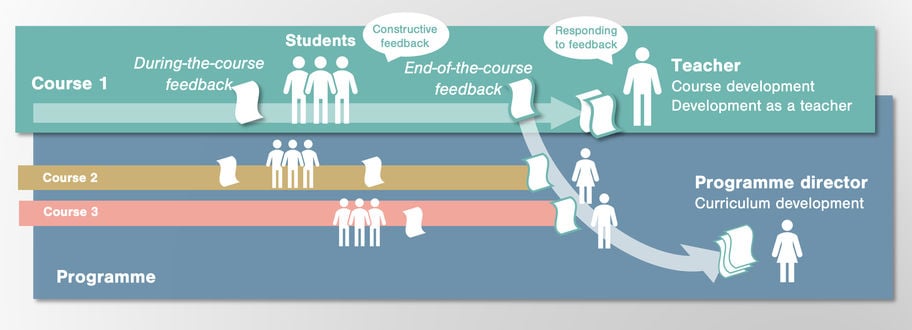Course feedback in Aalto University

Course development is a continual process, as it occurs both during the course and after it. Aalto´s PDCA cycle can be applied even here (PDCA cycle | Aalto University). After each course, student feedback is automatically collected via an electronic feedback tool in MyCourses. Teachers are also warmly encouraged to collect feedback on their teaching & students' learning during the actual course.
Besides the teacher, also the direction has access to course feedback data. Programme directors, department heads, school and university directors receive report summaries and can view course feedback data in different Power BI based tools. In addition to development of courses and teaching, the feedback collected is utilised in development discussions, curriculum development as well as in other strategic and pedagogical development work.
Course feedback information for students is offered in Student Guide's section Feedback and surveys.

Collecting course feedback
End-of-course feedback is collected via an online survey tool in MyCourses. The system retrieves course information from Sisu and creates a feedback survey in MyCourses. The teacher receives a notification two weeks before the start of the course. Through the emailed link, the teacher can add course-specific questions that help to develop the course.
Aalto questions, five items, are asked in all courses. In addition to the Aalto questions, there are also school-specific questions as a default in each feedback survey.
A week before the end of the course, a notification is automatically sent to the students so that they know it is time to give feedback. Despite the automated feedback tool, the teacher can substantially boost the feedback percentage with small measures.
When a minimum of 5 students have answered, the teacher can view the feedback report in MyCourses. In addition, report summaries for the direction are created twice a year.
Collecting and giving feedback during the course
Teachers are encouraged to collect feedback from their teaching already during the course. Feedback collected during the course enables small-scale adjustments in the teaching even during the course. There are a lot of ways to collect feedback that can be integrated in teaching: assignments, group discussions and feedback groups. Mid-course surveys can also be done with the course feedback tool in MyCourses. It is important to offer anonymous feedback channels, too.
Developing a course based on feedback
After the course, the teacher analyses the student feedback and reflects on it, planning possible future development measures. Peer discussions regarding the feedback and development have proven to be very beneficial.
According to Vice President's decision 16.5.2014 handling the feedback is one of the liabilities of the responsible teacher. The practical implementation varies a lot between schools and programmes: in some there is a common feedback event and in others the internal arrangements of the course are trusted to include this. In practise the teacher can, for example, share some of the feedback and the planned development actions with the students.
Below you can find some questions to help in the analysis and development:
- How successful was the course implementation?
- Did the students attain the learning outcomes set and at what level?
- How did the teaching and studying methods further the attainment of the learning outcomes?
- How did the central contents and the study material support learning?
- How did the assessment methods support learning and the assessment of learning?
- How did the students perceive the course workload?
- What contributes to inclusion in the course according to the students, and how can it be worked towards even more?
Making changes to a valid curriculum
Changes not requiring changing the course description can be made at the discretion of the teacher. Such changes include changes to the duration of a lecture series or instructions for a specific assignment. Part of the changes (such as lecture series information and detailed information) are written into the syllabus which has to be published three weeks before the course starts.
Careful and strategic degree-programme design and long-range planning of resources can avoid having to make changes to the curriculum in the middle of the two-year period. But in some cases, making the changes is justified. For more information, please see cases where changes to a valid curriculum are justified.
More course feedback related content:
The principles of feedback in education and student feedback in Aalto University
In Aalto, feedback is collected from students during different phases of their studies. Hearing the voice of students is vital for the development of teaching and training as well as for quality assurance and for improving study-related services. Feedback is used on multiple levels in many ways and its utilisation is a special area of focus in Aalto. Student guilds and organisations are also interested in and benefit from feedback and surveys.

Course feedback as a course element
Course feedback is a unique part of the feedback portfolio at Aalto university and it reaches students in all phases of their studies and is collected systematically throughout Aalto. Hearing the voice of students is vital for the development of teaching and education as well as for quality assurance and for improving study-related services. Feedback is used on multiple levels in many ways and its utilisation is a special focus area at Aalto.

Main page for instructions of course feedback tool
At Aalto University, course feedback is collected from almost all courses. On these pages you will find teacher's instructions for using the course feedback tool on MyCourses.

Course feedback questions
Here you'll find information about the content of course feedback surveys: common Aalto questions and school-specific questions as well as information and tips regarding course-specific questions.

Learning Services
- Published:
- Updated: